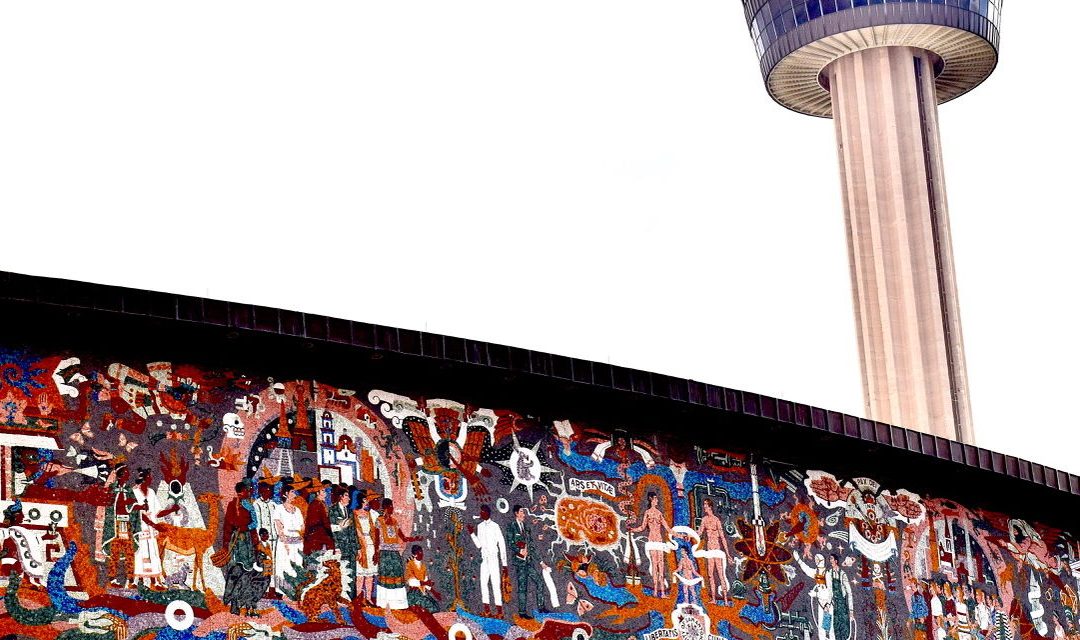San Antonians love art, and mural art is especially popular in the city’s Westside. Mural art made a dramatic appearance in the mid 1960s when Mexican artist and famed architect Juan O’Gorman created the “Confluence of Civilizations” mosaic mural for the 1968 HemisFair. Mexican painter Carlos Merida also received a commission to paint a mural inside a HemisFair building near the O’Gorman mural.
The story of how the O’Gorman mural came about intrigued a local writer Catherine Nixon Cooke, and her book, Juan O’Gorman: A Confluence of Civilizations, is an excellent account. For San Antonio’s first ever affiliation with a world’s fair, O’Gorman proposed a huge mosaic mural that would measure 130 x 22 feet.
At the time this would be one of the largest mosaic murals in North America. The fact that it would be completely constructed in Mexico City and shipped to San Antonio in 540 panels, each weighing nearly 100 pounds, made the process ever more daunting.
O’Gorman was no stranger to gigantic art projects. His reputation had grown internationally following his completion of the windowless fourteen story Central Library at the UNAM campus in Mexico City.
The building was overlaid completely in colorful mosaic art portraying the major historical events in the history of Mexico.
It was a remarkable achievement and attracted the attention of San Antonio businessman Marshall Steves and his wife Patricia. Steves was a member of the Steering Committee that had proposed the concept of HemisFair to Congressman Henry B. Gonzales. The congressman championed the idea and helped secure land and funds for San Antonio.
Flora Cameron Kampmann, a member of the HemisFair executive committee, stepped up to serve as the champion for the O’Gorman mural. Kampmann, a respected patron of the arts and community leader, supported the mural project with funding from her foundation.
In preparation for creating the mural, O’Gorman traveled throughout Mexico in 1966 searching for the ideal natural stones that would give the mural its color and imagery. He found ten varieties of stones with the different shades and colors he needed. At his studio in Mexico City he constructed the mural over a period of twelve months.
Upon the mural’s completion, San Antonio leaders reached out to E.H. Corrigan of Laredo for shipping and exporting help. His company arranged for the
transportation and duty-free passage. Shipped by trucks, the mural arrived in San Antonio in the fall of 1967.
The installation of the mural at the Convention Center required months of labor, dozens of workers, and several tall cranes. San Antonians had never witnessed a more complex artistic undertaking.
When HemisFair opened in April of 1968, Juan O’Gorman’s mural stood as the artistic highlight of the fair. What is remarkable about the mural is the predominance of Mexican imagery and icons which occupy nearly a third of the mural on the left side. There is no mistaking the panel’s dedication to Mexican history as O’Gorman includes Aztec chiefs surrounded by jaguars, eagles, and snakes–images common to modern Mexican murals.
The left side of the mural clearly celebrates Mexican history with the inclusion of Aztec warriors evolving into figures wearing the sombreros of the Mexican Revolution.
The panels on the far right side feature Greek and Roman figures as well as icons of that period. As we view the mural from rights to left, we see cowboys, farmers and astronauts representing North America, apparent hiers to Greek and Roman culture. Above the modern North American figures are rockets and satellites.
The imagery of this mural is unlike any major work ever painted in the Americas or Europe. O’Gorman’s design suggests several themes which are artistically divided into historical sections. At the center is the confluence of civilization as people linked by generations to ancient Mexican civilization join hands with the heirs to an old world represented by the Greeks and Romans. In terms of art and historical concepts, O’Gorman succeed in conveying a theme of confluence, continuity and inclusion.
By all accounts O’Gorman’s mural and HemisFair were a great success. With a new convention center and additional hotel rooms, thousands of tourists visited San Antonio for annual meetings and events. HemisFair gave San Antonio its Tower of the Americas, which enhanced the city’s skyline. The fair also allowed for the extension of the Riverwalk by a half mile and a later addition of a children’s park, theatre, and a cascading waterfall.
When the fair closed in the Fall of 1968, The State of Texas Pavillon, the largest on the 96 acres site, was converted to The Institute of Texan Cultures. Mexico turned its Pavillon into the Mexican Cultural Institute where ongoing venues include exhibits of Mexican art, academic lectures, regional dances, poetry readings and much more. The recent renovation of the Henry B. Gonzales Convention Center gave the O’Gorman mural the visibility it long deserved. The city demolished an older building which had partially blocked the mural’s view from the street. Today the O’Gorman mural stands as a treasure of San Antonio, once nearly hidden, but now a wondrous sight to behold.


Recent Comments